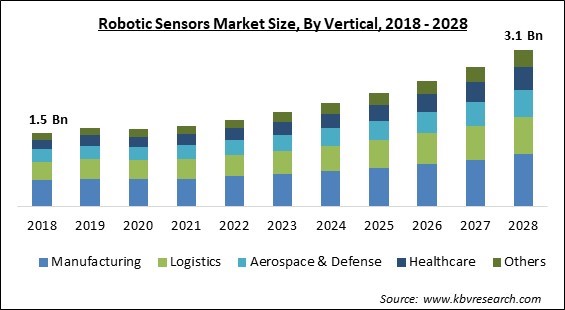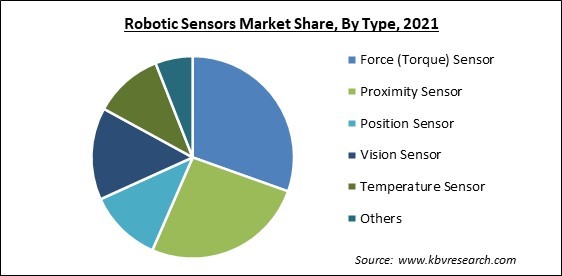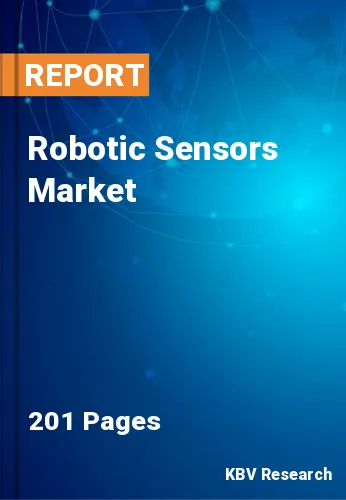The Global Robotic Sensors Market size is expected to reach $3.1 billion by 2028, rising at a market growth of 10.2% CAGR during the forecast period.
Robotic sensors are tools that assess the surroundings wherein the robot is functioning and enable the robot to modify its actions in response to data gathered. Because of Industry 4.0 and digitization, the utilization of robots has considerably grown over the forecast period. As robotics innovations result in versatile production models, it is projected that the use of industrial robot sensors in robotics would increase quickly in the coming years.

The implementation of autonomous and collaborative robots throughout end-user industries is also anticipated to raise the demand for robotic sensors. The robotic sensors market is expanding due to the rising requirement for automation and security in organizations as well as the development of reasonably priced, energy-efficient robots. The robotic sensors are developed as a result of rising labor and energy expenses as well as increased utilization of robotic sensors in various industry verticals.
One of the helpful technologies which are essential to the realm of robotics is the usage of sensors. These devices are crucial for safety assessment, quality control in work component inspection, interlocking in work cell control, and data collecting on the items in the robot work cell. In industrial robotics, sensors are employed to detect hazardous and safe situations in the robot cell architecture. By doing so, they serve to prevent bodily harm and other harm to human workers.
The robot work cell uses switches to govern a variety of equipment's actions, and sensors are utilized to confirm that the current work cycle has ended before moving on to the next one. Traditionally, quality control was carried out using a human inspection method. Presently, however, sensors are employed during the inspection procedure to identify specific quality characteristics of the work item. The sensors can only evaluate a small number of work part features and flaws, but they nonetheless produce very precise results.
Due to its severe effects on key supply chain stakeholders, the COVID-19 outbreak will have a significant effect on the improvement of consumer product safety testing solutions in 2020. On the other hand, the COVID-19 pandemic had a significant negative impact on the market because of several challenges, including a shortage of competent labor and delays or cancellations of projects owing to partial or total lockdowns around the world. Additionally, the market opportunity for robotic sensors beyond COVID-19 is anticipated to be strengthened by the rapid deployment of industrial and medical robots.
Numerous military & defense organizations have decided to introduce robots into their environments as a result of ongoing automation breakthroughs and accelerating robotics advancements. These robots have built-in sensors that let them carry out a wider range of warfare operations, from choosing snipers to engaging targets more successfully. For propulsion, weaponry controls, site monitoring, flight controls, and communications, military and defense organizations are installing sensors in a variety of security systems, crime detection systems, intrusion detection systems, explosives detection systems, and civil establishments.

Digital gadgets such as laptops, tablets, smartphones, and e-readers have become an essential part of everyday life. Most occupations necessitate working on computers for extended periods of time. In addition, the need of staying connected has increased with the rise of social networking sites. A worrying trend has been seen where people turn on their cell phones as soon as they get up and continue their trust with digital screens until they go to bed. In addition, the rising use of digital screens has given rise to a disorder called Computer Vision Syndrome (CVS), which harms the eyes and causes issues with vision.
While sensors are employed in a variety of applications, their restricted bandwidth and range prevent them from collecting data from far-off or remote places. Given that robotic sensor installations depend on electrical resources, it is essential to make sure that sensors can continue to function even when there is little power. Furthermore, depending on the sort of application they are used for, such sensors typically get a shelf life of six months to a year. This short shelf life creates the need for changing these sensors within a fixed interval of time, which is restricting many companies to use them in their products.
Based on type, the robotic sensors market is segmented into Proximity Sensor, Vision Sensor, Position Sensor, Temperature Sensor, Force (Torque) Sensor and Others. The proximity sensor segment procured a significant revenue share in the robotic sensors market in 2021. It is owing to the low cost attached to these sensors. This widespread application in the detection of items working in the area of the sensor is also expected to support growth. Multiple sensors are required for various proximity sensor targets.
On the basis of indication, the Robotic Sensors Market is fragmented into myopia, presbyopia, hypermetropia and astigmatism. In 2021, the astigmatism segment covered a significant revenue share in the orthokeratology market. The vision may become distorted or fuzzy if someone has astigmatism, a common condition of the eyes. It occurs when the cornea the transparent outer layer of the eye or lens the inner portion of the eye that aids in eye focus have an abnormal shape. The demand for ortho-k lenses is rising in this segment as spherical ortho-k lenses are available which have the ability to reshape the anterior surface of the cornea.
On the basis of vertical, the robotic sensors market is classified into Logistics, Aerospace and Defense, Manufacturing, Healthcare and Others. The manufacturing segment recorded the maximum revenue share in the robotic sensors market in 2021. It is due to the high acceptance of automation in manufacturing units. Throughout this industry, sensor-based collaborative & humanoid robots are employed for a variety of tasks like packaging, picking, rolling, and others.
| Report Attribute | Details |
|---|---|
| Market size value in 2021 | USD 1.6 Billion |
| Market size forecast in 2028 | USD 3.1 Billion |
| Base Year | 2021 |
| Historical Period | 2018 to 2020 |
| Forecast Period | 2022 to 2028 |
| Revenue Growth Rate | CAGR of 10.2% from 2022 to 2028 |
| Number of Pages | 201 |
| Number of Tables | 310 |
| Report coverage | Market Trends, Revenue Estimation and Forecast, Segmentation Analysis, Regional and Country Breakdown, Competitive Landscape, Companies Strategic Developments, Company Profiling |
| Segments covered | Type, Vertical, Region |
| Country scope | US, Canada, Mexico, Germany, UK, France, Russia, Spain, Italy, China, Japan, India, South Korea, Singapore, Malaysia, Brazil, Argentina, UAE, Saudi Arabia, South Africa, Nigeria |
| Growth Drivers |
|
| Restraints |
|
On the basis of vertical, the robotic sensors market is classified into Logistics, Aerospace and Defense, Manufacturing, Healthcare and Others. The manufacturing segment recorded the maximum revenue share in the robotic sensors market in 2021. It is due to the high acceptance of automation in manufacturing units. Throughout this industry, sensor-based collaborative & humanoid robots are employed for a variety of tasks like packaging, picking, rolling, and others.
Free Valuable Insights: Global Robotic Sensors Market size to reach USD 3.1 Billion by 2028
The market research report covers the analysis of key stake holders of the market. Key companies profiled in the report include TE Connectivity Ltd., Infineon Technologies AG, Omron Corporation, Honeywell International, Inc., ATI Industrial Automation, Inc., FANUC Corporation, Sensata Technologies Holdings PLC, Baumer Holding AG, Tekscan, Inc., and FUTEK Advanced Sensor Technology, Inc.
By Vertical
By Type
By Geography
The global Robotic Sensors Market size is expected to reach $3.1 billion by 2028.
Growing Demand For Robots In The Healthcare Sector are driving the market in coming years, however, Restricted Range And Shelf Life Of Sensors restraints the growth of the market.
TE Connectivity Ltd., Infineon Technologies AG, Omron Corporation, Honeywell International, Inc., ATI Industrial Automation, Inc., FANUC Corporation, Sensata Technologies Holdings PLC, Baumer Holding AG, Tekscan, Inc., and FUTEK Advanced Sensor Technology, Inc.
The expected CAGR of the Robotic Sensors Market is 10.2% from 2022 to 2028.
The Force (Torque) Sensor segment acquired maximum revenue share in the Global Robotic Sensors Market by Type in 2021 thereby, achieving a market value of $857.4 million by 2028.
The Asia Pacific market dominated the Global Robotic Sensors Market by Region in 2021, and would continue to be a dominant market till 2028; thereby, achieving a market value of $1.1 billion by 2028.
Our team of dedicated experts can provide you with attractive expansion opportunities for your business.

